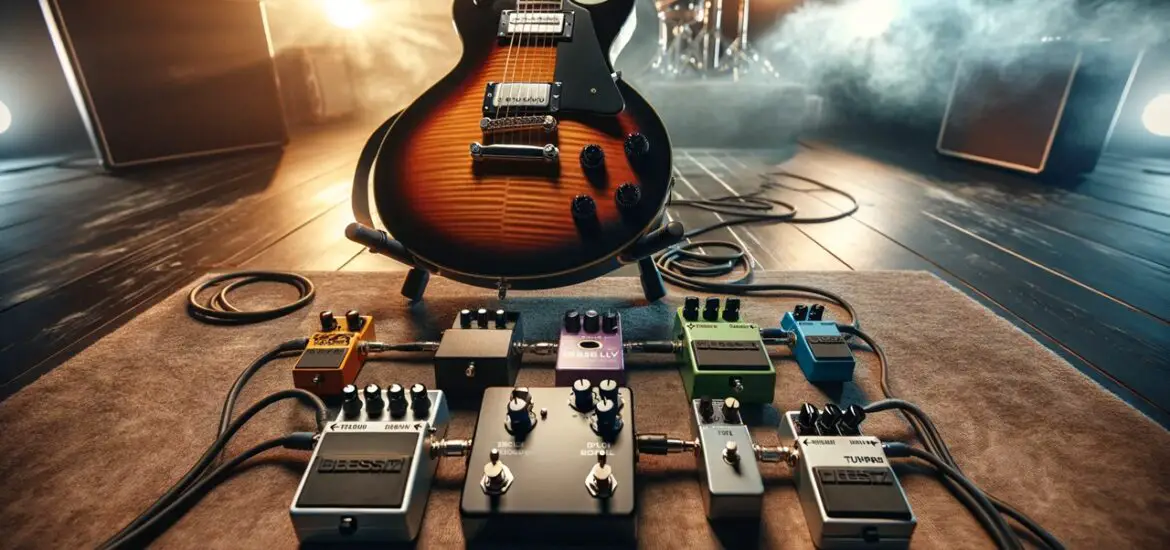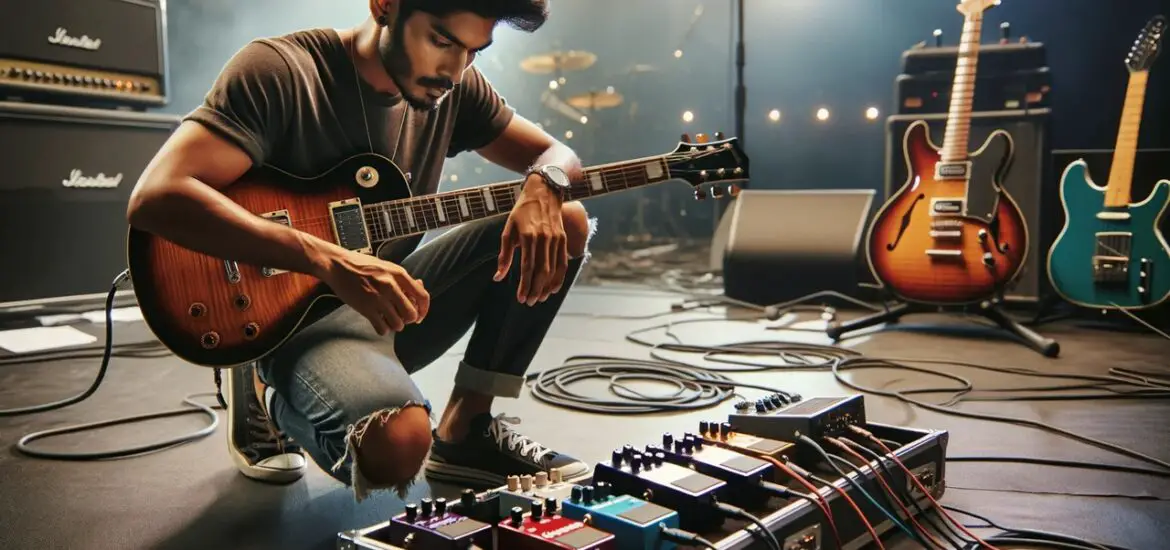If you’re wondering ‘what are guitar effects?’, you’re embarking on an exciting journey of musical exploration. This guide will walk you through the basics, types, setup, and integration of guitar effects, ensuring you have a comprehensive understanding of how to use them effectively.

What Are Guitar Effects?: Understanding the Basics
Guitar effects, whether in the form of electronic devices or software, play a pivotal role in sculpting the sound produced by your guitar.
These effects are not just about changing your sound; they open up a realm of sonic creativity, enabling you to add layers of depth, ambiance, and rhythm to your music. At times, they can even radically transform the tone, taking your sound to completely new territories.
Types of Guitar Effects and Their Uses
The world of guitar effects is vast, but it can be broadly categorized into five main types: distortion, dynamics, modulation, time-based, and filter effects. Each of these categories influences your guitar’s sound in a distinct manner, allowing for a wide range of sonic experimentation.
Distortion Effects
This category includes overdrive, fuzz, and distortion pedals. These effects are all about adding warmth, grit, and aggressiveness to your guitar tone. Overdrive gently pushes your amp harder, simulating the warm sound of a tube amplifier.
Fuzz, on the other hand, offers a more extreme form of distortion, creating a thick, saturated tone that’s iconic in genres like rock and blues. Distortion pedals provide a high gain sound, perfect for genres like metal and hard rock.
Dynamics Effects
Dynamics effects, such as compressors and noise gates, play a crucial role in managing the volume and sustain of your guitar’s sound. Compressors even out your guitar’s dynamic range, smoothing out the volume levels by amplifying quieter sounds and dampening louder ones.
This results in a more consistent sound that’s particularly useful in live performances. Noise gates are used to reduce unwanted background noise and hum, ensuring that your guitar’s tone remains clear and uncluttered.
Modulation Effects
This category includes effects like chorus, flanger, and phaser. They are designed to add texture and movement to your sound, creating a sense of depth and space. The chorus effect creates a shimmering, dreamy sound by slightly delaying your guitar signal and mixing it with the original signal.
Flangers produce a swirling effect, adding a unique character to your tone. Phasers create a sweeping, whooshing sound, perfect for adding a psychedelic touch to your music.
Time-based Effects
These effects, such as delay and reverb, are all about manipulating the time aspect of your guitar’s sound. Delay effects repeat your guitar’s signal, creating an echo effect that can range from a subtle repeat to a complex rhythmic pattern.
Reverb adds spatial depth to your sound, simulating the natural echoes you’d hear in different environments, from small rooms to large halls.
Filter Effects
Finally, filter effects like wah and envelope filters are used to shape the frequency content of your guitar’s sound.
Wah pedals create a sweeping effect by altering the frequency spectrum, producing the characteristic ‘wah-wah’ sound. Envelope filters, also known as auto-wahs, respond to your playing dynamics, changing the tone based on how hard you play.
Read more on guitars here – Common Guitar Questions: Guide to “What” Guitar Questions
Setting Up Your Guitar Effects
Setting up your guitar effects is a crucial step in crafting your unique sound. This process involves more than just connecting your guitar to various effects units; it’s about understanding how these connections and the order of your effects shape your overall tone.
Choosing Your Effects
First, decide whether you’ll use individual pedals or a multi-effects processor. Individual pedals offer distinct sounds and greater control over each effect, allowing you to mix and match different brands and types.
Multi-effects processors, however, provide a convenient all-in-one solution, often with the ability to save presets for easy recall.
Signal Chain Basics
The signal chain refers to the order in which your effects are connected. This order can drastically influence your sound. Typically, guitarists follow a certain sequence: starting with dynamics, followed by filter effects, then distortion, modulation, and finally time-based effects.
Connecting Dynamics Effects
Dynamics effects like compressors and noise gates are usually placed at the beginning of the signal chain. This positioning allows them to shape the raw signal from your guitar, evening out the dynamics before the signal undergoes further processing.
Adding Filter Effects
Next in line are filter effects, such as wah pedals. Placing them after dynamics but before distortion ensures that the filtering effect is more pronounced and that the wah pedal interacts more dynamically with the distorted sound.
Integrating Distortion Effects
Distortion, overdrive, and fuzz pedals typically come next. These pedals are most effective when they process a clean, uncompressed signal, which allows them to shape the distortion more accurately.
Inserting Modulation Effects
Modulation effects like chorus, flanger, and phaser usually follow distortion. If placed before distortion, the modulation effect can become less distinct. By positioning them after distortion, the modulation effects can enhance the harmonics and add depth to the distorted tone.
Concluding with Time-Based Effects
Finally, time-based effects such as delay and reverb are placed at the end of the chain. This order allows the delay and reverb to capture and process the cumulative effect of all prior pedals, creating a more cohesive and expansive sound.
Integrating Effects into Your Playing

Successfully integrating guitar effects into your playing is both an art and a science. It’s about striking the perfect balance between technical know-how and creative exploration. The journey to master this integration is as rewarding as it is challenging, and it begins with a thoughtful approach to each effect.
Start with One Effect
Embarking on this journey, it’s advisable to start simple. Choose one effect and spend time getting to know it intimately. Understand the nuances of how it changes your sound.
For example, with a distortion pedal, notice how different settings affect the grit and character of the distortion. If it’s a delay pedal, observe how altering the delay time and feedback transforms the echo effect.
Gradual Layering
Once you’re comfortable with one effect, begin to layer another. Pay close attention to how different effects interact and influence each other. The combination of a distortion pedal with a chorus effect, for instance, can create a lush, thick sound, while pairing it with a delay can lead to a spacious, atmospheric tone.
Experiment with Settings
Each effect pedal comes with a range of settings that can drastically alter your sound. Experiment with these settings to find what works best for you. Adjusting the rate of a phaser or the depth of a reverb can reveal a whole new dimension to your sound. This step is crucial in understanding the full potential of each effect.
Mindful Integration
As you become more adept at using multiple effects, it’s important to integrate them into your playing in a way that enhances your music, rather than overwhelming it.
Use effects to add texture and color to your sound, but be cautious of overdoing it. The effects should complement your playing style and the genre of music you’re playing, not dominate it.
Practice and Adaptation
Integrating effects into your playing is an ongoing process that requires regular practice. As you practice, you’ll develop a sense of how and when to use certain effects. This could mean using a subtle reverb to add depth to a quiet passage or engaging a wah pedal during a solo to add expressiveness.
Listen and Learn
Finally, listen to how other guitarists use effects. You can learn a lot by analyzing how your favorite guitarists apply different effects in their music. This can provide inspiration and new ideas for how to use effects in your own playing.
Conclusion: What Are Guitar Effects?
Understanding what guitar effects are and how to use them effectively can dramatically expand your musical expression. Remember, the world of guitar effects is vast and varied – there’s always something new to explore and integrate into your playing.